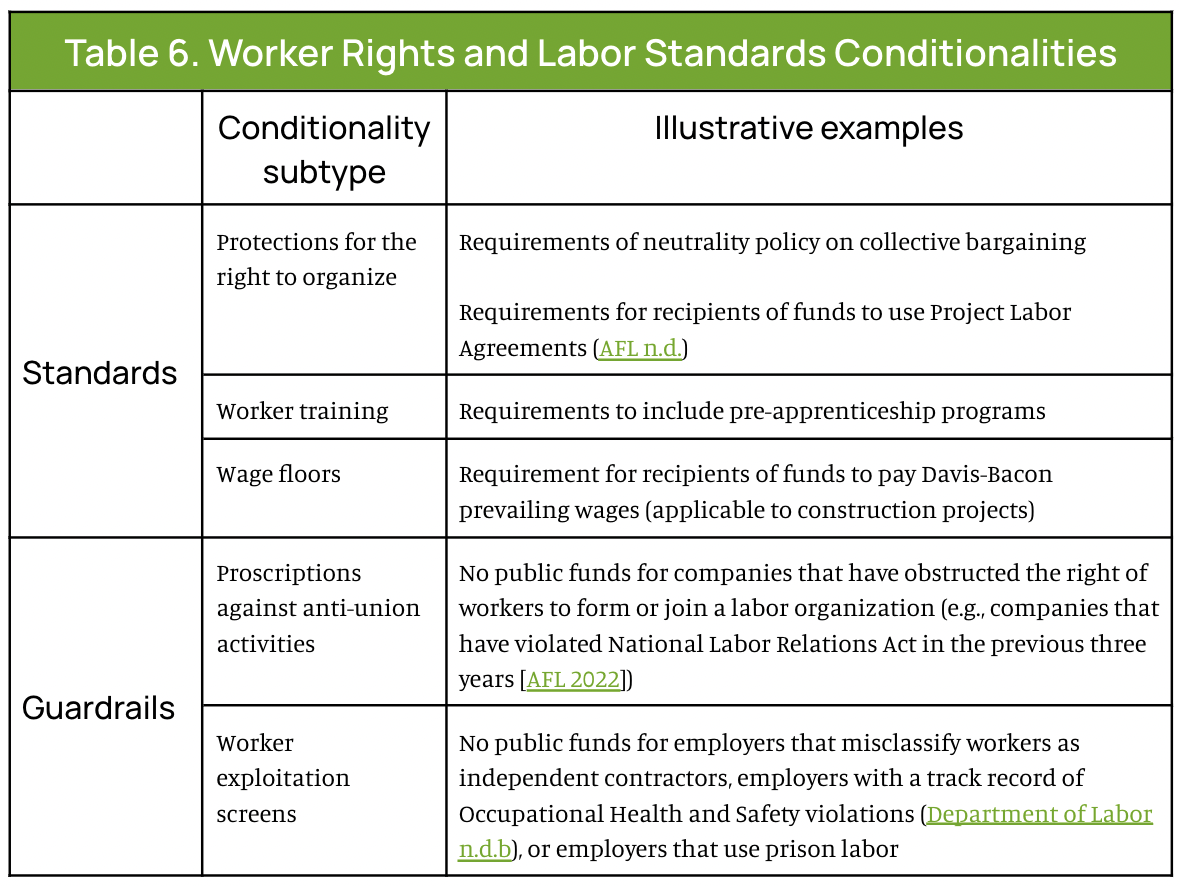Multi-Solving, Trade-Offs, and Conditionalities in Industrial Policy
October 26, 2023
By Isabel Estevez
Executive Summary
This policy brief addresses two intertwined challenges in industrial policy implementation: multi-solving (the practice of solving multiple problems at once through the same policy intervention) and the management of trade-offs between societal goals. Section I explains the importance of holistic thinking for (i) understanding the systemic impacts of industrial policies; (ii) minimizing trade-offs; and (iii) optimizing impact (multi-solving). Section II highlights the importance of trade-off identification as a precondition for trade-off resolution and for honest, empirically grounded decisions about which societal goals will be sacrificed for the sake of others. It also introduces practical tools for trade-off analysis and resolution. Section III explains how investment conditionalities—standards and guardrails—can be deployed to multi-solve and provides an overview of a range of conditionality types that have been proposed in the context of US industrial policy negotiations in recent years. I argue that, independently of the ethical reasons for minimizing trade-offs and simultaneously advancing multiple societal goals, the political climate calls for more ambitious multi-solving to secure ongoing momentum for a green transition.
Introduction
A year after the passage of the Inflation Reduction Act (IRA), one question continues to haunt the public debate about industrial policy implementation: At what point does adding too many secondary goals to an industrial policy intervention undermine its ability to accomplish its primary goal?
This question has sparked extensive, often heated debate among economic policy commentators. Some (legitimately) fear that trying to accomplish too many goals can severely hinder rapid implementation of urgent projects, like the expansion of clean energy infrastructure or the construction of public housing to address affordable housing shortages. Others (also legitimately) fear that policies that are too narrow will harm workers and communities, fail to build power for lasting change, and undermine accountability, leading to funds being misused and inequitably appropriated. Both are real risks.
Part of the reason the debate continues to drag on is that there is no generic answer to the question of how many goals are too many goals? The answer varies case by case. Every industrial policy challenge, from steel decarbonization to battery production, has its own particularities—its own set of stakeholders, internal tensions, power dynamics, underlying technological conditions, etc. Those particularities can also vary widely across geographies. This indeterminacy means that we also need to ask the aspirational version of the same question: How can we design industrial policy to serve as many societal goals as possible? This question urges us to approach the problem as a creative challenge with a view for maximizing positive impacts (i.e., multi-solving1), rather than starting from a position that a priori calls into question aspirational industrial policy goals and related efforts to place limits on corporate power.
Furthermore, there is a more fundamental, empirical version of the question: How does an industrial policy or project aimed at a particular goal (e.g., steel decarbonization) impact other societal goals or concerns (e.g., ending extreme poverty, protecting worker rights, or ending environmental racism)? As a matter of principle, any attempt to answer the question with regard to any specific industrial policy has to begin by identifying all the worthy goals that policy has the potential to serve—or undermine—and the trade-offs between them. Neglecting to do so seriously risks both gratuitously undermining important societal goals and missing opportunities to create synergies among them.
Drawing from innovation, industrial policy, and development scholarship, as well as empirical analysis of US industrial policy, this brief offers three practicable takeaways to help policymakers avoid those pitfalls and maximize public benefits:2
- Thinking holistically: When designing and implementing an industrial policy or project, it is always necessary to holistically analyze its relationship to a broad range of societal goals. Different streams of industrial policy and development scholarship show how an exhaustive mapping of public interest goals can serve as an analytical framework to elucidate the systemic relationships, intersections, and tensions between a policy’s primary goal and a range of other socially desirable objectives. This makes it possible to: (i) understand the likely impacts of a proposed policy holistically, (ii) identify potential trade-offs and synergies among goals; and (iii) rethink the design of the policy in a way that minimizes trade-offs and maximizes multi-solving.
- Identifying and managing trade-offs: Identifying trade-offs between an industrial policy’s central goal and other societal goals is a precondition for both trade-off resolution and honest, empirically grounded decisions about which goals will be sacrificed for the sake of others. Some trade-offs cannot be resolved and require hard choices, but many can. Once potential trade-offs are identified, various tools can be deployed to manage them. In fact, there are entire streams of innovation literature devoted to analytical tools for distinguishing between real and perceived trade-offs, as well as methodologies for overcoming trade-offs through creative design. These literatures offer practicable insights for policy innovation and for personnel development. Trade-off analysis of this kind is indispensable for bringing to light and correcting our historic practice of designing economic policy in a way that routinely sacrifices the health and well-being of marginalized groups—especially Black and Indigenous communities.
- Using multi-solving tools: Policy design, like politics, is an art, and conditionalities (standards and guardrails) can serve as modular design features that can make the difference between an industrial policy that advances societal goals and one that undermines them. Industrial policy shapes, not just what goods and services we produce, but also how we produce them, and the real-world impacts of industrial policy depend on the how just as much as the what. Conditionalities shape the how. In the US, a range of industrial policy conditionalities—from labor and accountability standards to guardrails against worker exploitation and environmental injustice—have been put forth by social actors to better align government action with a range of societal objectives. Given the direction of the political winds, the use of conditionalities to enable multi-solving may prove vital to the sustainability of emerging industrial policies, which risk alienating social actors like the labor and the environmental justice movement—crucial electoral constituencies.

Table References (AFL n.d., AFL 2022, Department of Labor n.d.b)
This table illustrates some labor conditionalities (standards and guardrails) for industrial policy. Workers’ rights conditionalities can help ensure fair treatment of workers and curb corporate practices that undermine workers’ rights (e.g., wage standards and proscriptions against distribution of funds to companies with labor rights violations).
Footnotes
1 For the purposes of this brief, we define “multi-solving” simply as the practice of solving multiple problems at once—a practice that is generally aided by systems thinking. Scholarly literature related to multi-solving and systems thinking is varied and wide-ranging across academic disciplines, from innovation theory to sustainability studies. Prominent examples include Meadows 2008 and Fey and Rivin 2005.
2Note that this brief does not seek to make recommendations about how specific trade-offs should be addressed or resolved, but rather to provide a framework for trade-offs identification and analysis.
Key Takeaways
One way that the multi-solving framework can be applied to today's industrial policy of choice—public investment—is through the use of investment conditionalities:
- Public value and economic security conditionalities can be used to amplify the public benefits of investments, whether by strengthening their capacity to deliver on their core mission or by creating synergies that deliver public value in domains outside the core of a policy’s core mission (e.g., bans on shareholder buybacks, profit-sharing requirements, and domestic content requirements).
- Equity, well-being, and human rights conditionalities can be used to ensure a fairer distribution of benefits, to prevent a deepening of inequities, or to enhance the positive impact of investments on the well-being of those negatively impacted by different types of systemic inequities (racial, socioeconomic, etc.) (e.g., equitable hiring standards, funding set-asides for low-income communities, and guardrails against investments that worsen the pollution burden for impacted communities).
- Environmental conditionalities can help curb the environmental impact of investments and create incentives for cleaner forms of production across economic sectors (e.g., guardrails against investments in fossil fuel projects or projects or sustainable government procurement standards).
- Workers’ rights conditionalities can help ensure fair treatment of workers and curb corporate practices that undermine workers’ rights (e.g., wage standards and proscriptions against distribution of funds to companies with labor rights violations).
- Governance and accountability conditionalities can be used to build buy-in and viability, as well as to create civic capabilities to hold governments accountable for improving community well-being and delivering public value (e.g., community benefit agreements or oversight requirements).
Related Resources
A Progressive Take on Permitting Reform: Principles and Policies to Unleash a Faster, More Equitable Green Transition
Read the report Opens in new windowUsing Industrial Policy for Productive Transformation: Three Lessons from Development Economics for US Industrial Strategy
Read the brief Opens in new windowThe Need for Corporate Guardrails in US Industrial Policy
Read the brief Opens in new window

